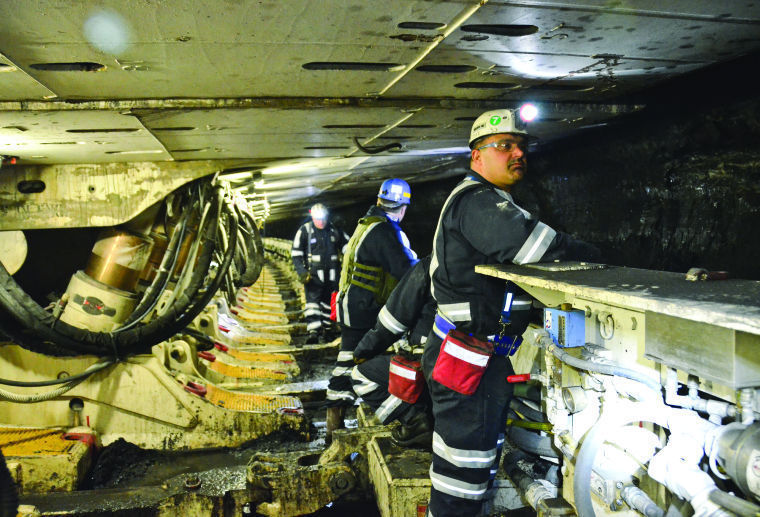West Virginia Coal Industry Looking to Recover After Decade of Production Downturn

By Charles Young
April 14, 2019 - While much of the focus has shifted to West Virginia’s oil and gas industry in recent years, industry experts say coal still plays a big role in the Mountain State.
The industry reached a production peak in 2008, when nearly 158 million short tons were mined. Over the next decade, production levels slowed until reaching a 40-year low of just 80 million short tons in 2016.

Coal miners work in the Leer Mining Complex in Taylor County. In February, Arch Coal announced plans to build a similar facility in Barbour County.
According to Bill Raney, president of the West Virginia Coal Association, the industry is in the process of trying to recover.

Bill Raney
“We’re on the rebound from 2016, which was our lowest point,” he said. “In 2017, we picked up around 10 to 12 million tons and then picked up another 8 to 10 million the next year. At the end of 2018, we had produced right around 100 million tons.”
There are about 14,000 full-time coal miners working in West Virginia who are supported by around 35,000 contractors, Raney said.
Coal is mined in 26 of the state’s 55 counties, Raney said.
“In many of those counties, (coal) is probably the largest private investment that is made in the county,” he said. “And they are probably the largest employer, not by (workforce) numbers, but by payroll.”
James Wood, interim director of the Energy Institute at West Virginia University, said the state’s coal industry can be divided into three sections: Steam coal, metallurgical coal and coal for export.
“West Virginia’s coal supply is abundant and of good quality. So as far as domestic demand for met coal is concerned, West Virginia will be a major supplier to the U.S., as along as the economy continues to grow, and may favorably compete for international markets,” he said. “Steam coal is in decline domestically, and attempts to award credits to electric generators that use steam coal may slow the pace of retirements, but are unlikely to encourage public and private electric generators to initiate permitting and development efforts on new coal generation.
“On the other hand, West Virginia’s steam coal is good quality and should be cost competitive with Australian and Indonesian coal. India and China will turn to higher quality coal — like coal from West Virginia and Northern Australia — as they develop higher efficiency cycles.”
In February, Arch Coal announced plans to build a new mine in the Barbour County area.
The facility is expected to produce around 3 million tons of coking coal annually and provide opportunities for 600 local workers.
The new mine, Leer South, will be similar to Arch’s existing Leer longwall mine in Taylor County. The mine will operate in the same 200-million-ton reserve base as the Leer operation, according to company officials.
Arch expects to invest approximately $360 million to $390 million over the next three years to develop the new mine, with the longwall scheduled to start up in late 2021.
“We are excited about this new project, which we view as transformational for Arch Coal and its shareholders,” said John Eaves, Arch’s CEO. “With the addition of Leer South, Arch will greatly enhance its portfolio of world-class coking coal assets and cement our position as the premier global producer of High-Vol A coking coal.

John Eaves
“We believe there is significant unfulfilled global demand for High-Vol A coking coal generally, and our Leer brand specifically, and are already engaged in discussions with leading steel producers around the world that are eager to secure additional volumes of our Leer-brand products,” Eaves said.
The company plans to sell the output from the Leer South complex principally into the 300-million-metric-ton-per-year seaborne coking coal market.
Steel market experts expect solid demand growth for seaborne coking coal over the next 10 years, driven by substantial steel-sector growth in India and other rapidly emerging Asian economies, according to the company.
“Given our outlook for continued strong cash generation, along with other steps we have taken to increase liquidity, we expect to fund 2019 expenditures for the new development with internally generated cash and cash on hand,” Eaves said. “Even with the projected increase in our 2019 capital spending budget, which includes approximately $90 million related to the Leer South project, we expect to have the capability to continue our share buyback program at similar levels to 2018, should we opt to do so.”
In addition to its plans for Leer South, Arch announced it would transition its Mountain Laurel operation from longwall to room-and-pillar mining at the beginning of 2020, and move the Mountain Laurel longwall equipment to Leer South at that time.
Cheryl Wolfe, executive director of the Barbour County Economic Development Authority, said Arch’s announcement is good news for the area as a whole.

Cheryl Wolfe
“We ’re very excited about it and are glad Arch Coal is investing in our county,” she said. “I think this will be great for our county. These jobs will create a lot of indirect employment.”
Raney said he expects operators in the North Central West Virginia region to continue investing in their existing facilities over the next few years.
“I think there will be some expansions of existing mines,” he said. “They will continue expanding the surrounding infrastructure, and that’s very encouraging to see.”
The long-term future of coal mining in West Virginia will be determined by a combination of numerous political and economic factors, but industry insiders think its future is bright, Raney said.
“We’re hopeful that it’s positive,” he said. “We hope for the continued strength of the export market. We hope to gain back some of the market that we lost in the steam coal markets around the South and the East. If we can get to and keep ourselves around 100 million tons of annual production in West Virginia, I think we can continue.”
According to a study from the WVU Bureau of Business & Economic Research, the coal industry is estimated to remain “relatively stable” through the early 2020s.
Statewide coal production is expected to fall below 80 million tons by 2030 and decline further through 2040, according to the study.

